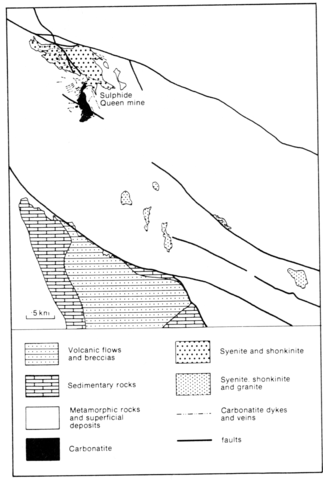stripes
The Mountain Pass district lies in a block of Precambrian metamorphic rocks which includes garnet, mica, hornblende and sillimanite gneisses and schists, amphibolite and granitic gneisses, migmatites and pegmatites. These are intruded by seven stocks of shonkinite, syenite and granite with associated dykes which are characteristically highly potassic. Carbonatite was then emplaced as a north-south-trending, tabular intrusion - the Sulphide Queen body - and as numerous dykes and veins. The carbonatites are post-dated by a series of much younger basaltic to rhyolitic dykes. The large intrusion in the north of the area is a composite shonkinite-syenite stock which in general is highly heterogeneous, the rock often being brecciated and cut by ramifying veins and dykes of syenitic and granitic composition. Brecciation is particularly marked along some contacts, while gneiss inclusions as well as the country rocks have been fenitized. The shonkinites contain 25-40% biotite, 5-40% pyroxene plus amphibole and about 25% alkali feldspar. The pyroxene varies from augite to aegirine-augite and aegirine and the amphibole from hornblende to riebeckitic and arfvedsonitic varieties. Possible pseudoleucite has been noted in one sampled rock, and olivine is sometimes present. The description of the shonkinites by Olsen et al. (1954) suggests affinities with fenites. Syenite is also very variable from leucocratic to mesocratic varieties and quartz may or may not be present. The feldspar is variably orthoclase, microcline and perthite, and biotite is the most abundant mafic mineral, pyroxene and amphibole being variable, as in the shonkinites, and including veinlets and films of crocidolite. Smaller bodies in the south of the district comprise three mixed shonkinite-syenite intrusions, two of which are predominantly of syenite and one of granite. The mixed bodies are similar to the northern one in their heterogeneity, shonkinite being concentrated near the margins, occurring as blocks in the syenite and cut by syenite veins. The mineralogy is again dominated by alkali feldspar, biotite and sodic pyroxene and amphiboles. The granite of the single body of this rock type contains up to 40% quartz, alkali feldspar and minor mafics including sodic amphiboles. These suites of rock contain 7.0-11.2% K2O and 0.3-1.4% Na2O (Olsen et al., 1954, Table 4). The Sulphide Queen carbonatite is about 750 m long and averages 130 m in width. Apophyses extend into the country rock gneiss and satellite bodies up to 60 m long occur close by. Near to the border gneiss inclusions are numerous and these and the contact rocks have developed phlogopite-rich zones. Three types of carbonatite have been mapped which are, from oldest to youngest: (1) brown ferruginous dolomitic carbonatite with baryte and monazite and minor apatite, calcite, bastnaesite, parisite, sahamalite, magnetite and hematite; (2) grey calcite-pink baryte carbonatite which is the most abundant carbonatite, and comprises 40-75% calcite, 15-50% baryte, 5-15% bastnaesite, crocidolite, chlorite, quartz, goethite and minor apatite, allanite, zircon, galena, hematite, magnetite and pyrite: and (3) silicified carbonatite consisting essentially of bastnaesite (up to 60%), baryte and quartz, with calcite and minor allanite, galena and crocidolite. Aragonite veins cut all the carbonatites. Carbonatite dykes and veins occur throughout the area but are particularly abundant north of the Sulphide Queen body within the shonkinite. They vary from a few centimeters to 6 m or more in thickness and vary markedly in mineralogy along their length. The principal mineral associations are calcite-baryte-bastnaesite, calcite-baryte, siderite-baryte-bastnaesite-quartz, ankerite-baryte, ankerite-fluorite and quartz alone. Bastnaesite-bearing calcite dykes and veins are the most numerous, with baryte ranging between 5 and 30% and bastnaesite up to 30%. Mineralized shear zones up to 6 m wide grade into carbonatite dykes and occur as en echelon swarms near the Sulphide Queen carbonatite; they contain carbonate, baryte, quartz and locally bastnaesite and thorite. A full list of the minerals occurring at Mountain Pass will be found in Olson et al. (1954, p. 33). Data on the sulphur isotope geochemistry of galena will be found in Mitchell and Krouse (1975) and the lead isotope chemistry in Mitchell (1973); a 87Sr/86Sr ratio is given by Powell (1966).
LANPHERE, M.A. 1964. Geochronologic studies in the eastern Mojave Desert, California. Journal of Geology, 72: 381-99.
MITCHELL, R.H. 1973. Isotopic composition of lead in galena from the Mountain Pass carbonatite, California. Nature (Physical Science) London, 241: 17-8.
MITCHELL, R.H. and KROUSE, H.R. 1975. Sulphur isotope geochemistry of carbonatites. Geochimica et Cosmochimica Acta, 39: 1505-15.
OLSON, J.C., SHAWE, D.R., PRAY, L.C. and SHARP, W.N. 1954. Rare-earth mineral deposits of the Mountain Pass district, San Bernardino County, California. Professional Paper, United States Geological Survey, 261: 1-75.
POWELL, J.L. 1966. Isotopic composition of strontium in carbonatites and kimberlites. Mineralogical Society of India, IMA Volume, (Fourth General Meeting, New Delhi, 1964): 58-66.
WARHOL, W.N. 1980. Molycorp's Mountain Pass operations. In D.L. Fife and A.R. Brown (Eds). Geology and mineral wealth of the California desert. South Coast Geological Society (Dibblee Volume):359-66

